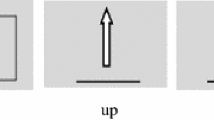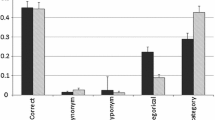Abstract
The present study examined the general hypothesis that, as for nouns, stable representations of semantic knowledge relative to situations expressed by verbs are available and accessible in long term memory in normal people. Regular associations between verbs and past tenses in French adults allowed to abstract two superordinate semantic features in the representation of verb meaning: durativity and resultativity. A pilot study was designed to select appropriate items according to these features: durative, non-resultative verbs and non-durative, resultative verbs. An experimental study was then conducted to assess semantic priming in French adults with two visual semantic-decision tasks at a 200- and 100-ms SOA. In the durativity decision task, participants had to decide if the target referred to a durable or non-durable situation. In the resultativity decision task, they had to decide if it referred to a situation with a directly observable outcome or without any clear external outcome. Targets were preceded by similar, opposite, and neutral primes. Results showed that semantic priming can tap verb meaning at a 200- and 100-ms SOA, with the restriction that only the positive value of each feature benefited from priming, that is the durative and resultative values. Moreover, processing of durativity and resultativity is far from comparable since facilitation was shown on the former with similar and opposite priming, whereas it was shown on the latter only with similar priming. Overall, these findings support Le Ny’s (in: Saint-Dizier, Viegas (eds) Computational lexical semantics, 1995; Cahier de Recherche Linguistique LanDisCo 12:85–100, 1998; Comment l’esprit produit du sens, 2005) general hypothesis that classificatory properties of verbs could be interpreted as semantic features and the view that semantic priming can tap verb meaning, as noun meaning.
Similar content being viewed by others
References
Barsalou L.W. (1993). Challenging assumptions about concepts. Cognitive Development 8, 169–180
Barsalou L.W. (1999) Perceptual symbol systems. Behavioral and Brain Sciences 22, 577–609
Becker C.A. (1980). Semantic context effects in visual word recognition: An analysis of semantic strategies. Memory and Cognition 8, 493–512
Bird H., Howard D., Franklin S. (2000a) Why is a verb like an inanimate object? Grammatical category and semantic category deficits. Brain and Language 72, 246–309
Bird H., Lambon Ralph M.A., Patterson K., Hodges J.R. (2000b) The rise and fall of frequency and imageability: Noun and verb production in semantic dementia. Brain and Language 73, 17–49
Bonnotte I., Fayol M. (1997) Cognitive representations of predicates and the use of past tenses in French: A developmental approach. First Language 17, 75–101
Caramazza A., Hillis A.E. (1991) Lexical organization of nouns and verbs in the brain. Nature 349, 788–790
Cohen J.D., MacWhinney B., Flatt M., Provost J. (1993) PsyScope: A new graphic interactive environment for designing psychology experiments. Behavioral Research Methods, Instruments & Computers 25, 257–271
Collins A.M., Loftus E.F. (1975) A spreading-activation theory of semantic processing. Psychological Review 82: 407–428
Comrie B. (1976) Aspect: An introduction to the study of verbal aspect and related problems. Cambridge University Press, Cambridge
Comrie B. (1985) Tense. Cambridge University Press, Cambridge
Content A., Mousty P., Radeau M. (1990) Brulex: Une base de données lexicales informatisées pour le français écrit et parlé. L’Année Psychologique 90, 551–566
Cree G.S., McRae K., McNorgan C. (1999) An attractor model of lexical conceptual processing: Simulating semantic priming. Cognitive Science 23, 371–414
de Groot A.M.B. (1984) Primed lexical decision: Combined effects of the proportion of related prime-target pairs and the stimulus-onset asynchrony of prime and target. The Quarterly Journal of Experimental Psychology 36A: 253–280
de Groot A.M.B. (1990) The locus of the associative priming effect in the mental lexicon. In: Balota D.A., Flores d’Arcais G.B. (eds). Comprehension processes in reading. Erlbaum, Hillsdale, pp. 101–123
de Mornay Davies P., Funnell E. (2000) Semantic representation and ease of predication. Brain and Language 73, 92–119
den Heyer K., Briand K., Dannenbring G.L. (1983) Strategic factors in a lexical-decision task: Evidence for automatic and attention-driven processes. Memory & Cognition 11, 374–381
Fayol M., Abdi H., Gombert J.E. (1989) Use of past tense verb inflections in French: Developmental study of the interaction between type of process and context. European Bulletin of Cognitive Psychology 9, 279–295
Fayol, M., Gombert, J. E., & Abdi, H. (1988). Temps et types de procès. Une étude descriptive et développementale. In N. Tersis & A. Kihm (Eds.), Temps et aspects (pp. 239–254). Actes du colloque C.N.R.S., Paris, 24-25 octobre 1985. Paris: Peeters/Self 248.
Fayol M., Hickmann M., Bonnotte I., Gombert J.E. (1993) The effects of narrative context on French verbal inflections: A developmental study. Journal of Psycholinguistic Research 4, 453–478
Ferretti T.R., McRae K., Hatherell A. (2001) Integrating verbs, situation schemas, and thematic role concepts. Journal of Memory and Language 44, 516–547
François J. (2003) La prédication verbale et les cadres prédicatifs. Editions Peeters, Louvain
Franquart-Declercq, C., Le Ny, J. F., & Monnier, S. (2004). Les co-occurrences verbes/patients dans l’environnement linguistique des locuteurs jouent-elles un rôle dans leur acquisition des significations des verbes transitifs? Journée Scientifique “Sémantique des verbes et interprétation de l’action”, Saint-Denis, 18 novembre.
Fuchs, C., & Leonard, A. M. (1979). Vers une théorie des aspects. Paris: Mouton et E.H.E.S.S.
Gough, P. B., & Cosky, M. J. (1977). One second of reading again. In N. J. Castellan, Jr., D. B. Pisoni, & G. R. Potts (Eds.), Cognitive theory (Vol. 2, pp. 271–288). Hillsdale: Erlbaum.
Hutchison K.A. (2003) Is semantic priming due to strength or feature overlap? A microanalytic review. Psychonomic Bulletin & Review 10, 785–813
Kemmerer D., Tranel D. (2000a) Verb retrieval in brain-damaged subjects: 1. Analysis of stimulus, lexical, and conceptual factors. Brain and Language 73, 347–392
Kemmerer D., Tranel D. (2000b) Verb retrieval in brain-damaged subjects: 2. Analysis of errors. Brain and Language 73, 393–420
Kim M., Thompson D.K. (2000) Patterns of comprehension and production of nouns and verbs in agrammatism: Implications for lexical organization. Brain and Language 74, 1–25
Langacker R.W. (1999) A view from cognitive linguistics. Behavioral and Brain Sciences 22, 625
Le Ny J.F. (1995) Mental lexicon and machine lexicon: Which properties are shared by machine and mental word representations? Which are not?. In: Saint-Dizier P., Viegas E. (eds). Computational lexical semantics. Cambridge University Press, Cambridge, pp. 50–67
Le Ny J.F. (1998) La sémantique des verbes et la représentation des situations. Cahier de Recherche Linguistique LanDisCo 12, 85–100
Le Ny J.F. (2005). Comment l’esprit produit du sens. Odile Jacob, Paris
Le Ny J.F., Franquart-Declercq C. (2001) Flexibilité des significations, traits sémantiques et compréhension des métaphores verbales. Verbum 23(4): 385–400
Le Ny J.F., Franquart-Declercq C. (2002) Signification des verbes, relation verbe/patient et congruence sémantique. Le Langage et l’Homme 37, 9–26
Lucas M. (2000) Semantic priming without association: A meta-analytic review. Psychonomic Bulletin & Review 7, 618–630
Lund, K., Burgess, C., & Atchley, R. A. (1995). Semantic and associative priming in high-dimensional semantic space. In Cognitive Science Society (Ed.), Proceedings of the 17th Annual Conference of the Cognitive Science Society (pp. 660–665). Hillsdale: Lauwrence Erlbaum Associates, Inc.
Lund, K., Burgess, C., & Audet, C. (1996). Dissociating semantic and associative word relationships using high-dimensional semantic space. In Cognitive Science Society (Ed.), Proceedings of the 18th Annual Conference of the Cognitive Science Society (pp. 603–608). Hillsdale: Lauwrence Erlbaum Associates, Inc.
Masson M.E.J. (1995) A distributed memory model of semantic priming. Journal of Experimental Psychology: Learning, Memory, and Cognition 21: 3–23
McKoon G., Ratcliff R. (1992) Spreading activation versus compound cue accounts of priming: Mediated priming revisited. Journal of Experimental Psychology: Learning, Memory, and Cognition, 18: 1155–1172
McNamara T.P. (1992) Priming and constraints it places on theories of memory and retrieval. Psychological Review 99: 650–662
McNamara T.P. (2005) Semantic priming: Perspectives from memory and word recognition. Psychology Press, New York
McRae K., Boisvert S. (1998) Automatic semantic similarity priming. Journal of Experimental Psychology: Learning, Memory, and Cognition 24: 558–572
McRae K., Cree G.S., Westmacott R., de Sa V.R. (1999) Further evidence for feature correlations in semantic memory. Canadian Journal of Experimental Psychology 53: 360–373
McRae K., de Sa V.R., Seidenberg M.S. (1997a) On the nature and scope of featural representations of word meaning. Journal of Experimental Psychology: General 126: 99–130
McRae K., Ferretti T.R., Amyote L. (1997b) Thematic roles as verb-specific concepts. Language and Cognitive Processes 12: 137–176
McRae K., Spivey-Knowlton M.J., Tanenhaus M.K. (1998) Modeling the influence of thematic fit (and other constraints) in on-line sentence comprehension. Journal of Memory and Language 38: 1–30
Meyer D.E., Schvaneveldt R.W. (1971) Facilitation in recognizing pairs of words: Evidence of a dependence between retrieval operations. Journal of Experimental Psychology 90: 227–234
Meyer D.E., Schvaneveldt R.W., Ruddy M.G. (1975) Loci of contextual effects on visual word recognition. In: Rabbitt P.M.A., Dornic S. (eds). Attention and performance (Vol. V, pp. 98–118). New York: Academic Press.
Moss H.E., Ostrin R.K., Tyler L.K., Marslen-Wilson W.D. (1995) Accessing different types of lexical semantic information: Evidence from priming. Journal of Experimental Psychology: Learning, Memory, and Cognition 21: 863–883
Neely J.H. (1977) Semantic priming and retrieval from lexical memory: Roles of inhibitionless spreading activation and limited-capacity attention. Journal of Experimental Psychology: General 106: 226–254
Neely J.H. (1991) Semantic priming effects in visual word recognition: A selective review of current findings and theories. In: Besner D., Humphreys G.W. (eds). Basic processes in reading. Erlbaum, Hillsdale, pp. 264–336
Perea M., Rosa E. (2002) The effects of associative and semantic priming in the lexical decision task. Psychological Research 66, 180–194
Plaut, D. C. (1995). Semantic and associative priming in a distributed attractor network. In Cognitive Science Society (Ed.), Proceedings of the 17th Annual Conference of the Cognitive Science Society (pp. 37–42). Hillsdale: Lauwrence Erlbaum Associates, Inc.
Plaut D.C., Booth J.R. (2000) Individual and developmental differences in semantic priming: Empirical and computational support for a single-mechanism account of lexical processing. Psychological Review 4, 786–823
Posner, M. I., & Snyder, C. R. R. (1975). Facilitation and inhibition in the processing of signals. In P. M. A. Rabbitt & S. Dornic (Eds.), Attention and performance (Vol. 5, pp. 669–682). New York: Academic Press.
Ratcliff R., McKoon G. (1988) A retrieval theory of priming in memory. Psychological Review 95: 385–408
Rayner K. (1978) Eye movements in reading and information processing. Psychological Bulletin 85, 618–660
Reichenbach H. (1947) Symbolic logic. University of California Press, Berkeley
Rosch E., Mervis C.B. (1975) Family resemblances: Studies in the internal structure of categories. Cognitive Psychology 7: 573–605
Rosch E., Mervis C.B., Gray W.D., Johnson D.M., Boyes-Bream P. (1976) Basic objects in natural categories. Cognitive Psychology 8: 382–439
Shelton J.R., Martin R.C. (1992) How semantic is automatic semantic priming. Journal of Experimental Psychology: Learning, Memory, and Cognition 18: 1191–1210
Vendler Z. (1967) Verbs and times. In: Vendler Z. (eds). Linguistics in philosophy. Cornell University Press, Ithaca, pp. 97–121
Vet C. (1980) Temps, aspects et adverbes de temps en français contemporain: essai de sémantique formelle. Droz, Genève
Williams J.N. (1996). Is automatic priming semantic?. European Journal of Cognitive Psychology 8: 113–161
Author information
Authors and Affiliations
Corresponding author
Rights and permissions
About this article
Cite this article
Bonnotte, I. The Role of Semantic Features in Verb Processing. J Psycholinguist Res 37, 199–217 (2008). https://doi.org/10.1007/s10936-007-9066-7
Published:
Issue Date:
DOI: https://doi.org/10.1007/s10936-007-9066-7




